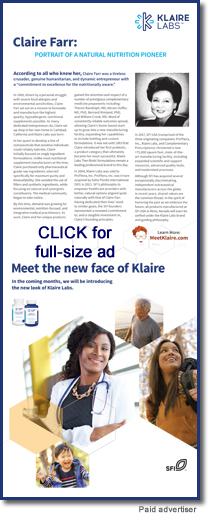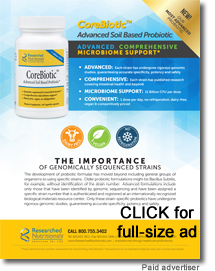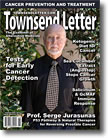|
It is an unfortunate truth that with age comes a higher risk of cancer. As a matter of fact, 60% of people who have been diagnosed with cancer and 60% of cancer survivors are age 65 or older. However, age is just one of many factors in cancer, and there are not only numerous new methods for attempting to lower the risk of developing cancer but also new treatments. Studies have shown that doctors do not always offer older adults an exhaustive list of all of the treatments currently available. People of all ages have the right to know all treatment options, in order to make an informed decision along with the doctor. In this column, we review recent studies that explore the latest advances in cancer prevention and treatment.
Aging and Cancer. http://www.cancer.net/navigating-cancer-care/older-adults/aging-and-cancer
 Eating to Starve Prostate Cancer Eating to Starve Prostate Cancer
University of Texas at Austin researchers have found natural compounds in specific types of food that can starve or even prevent cancer. These ingredients and foods include turmeric, curry, red grapes, green tea, and apple peels. This is an especially important finding as prostate cancer is the most common type of cancer for men in the United States. Prostate cancer is commonly highlighted during June as it is Men's Health Month.
Cancer research across the past decade has uncovered the potential for plants to slow or even prevent the onset of cancer. Such compounds in plants reduce the risk factors for inflammation and cancer within the human body. Those who endure chronic inflammation due to autoimmune disease, chronic infection, or conditions like obesity have an elevated risk for cancer due to damage to their body's normal cells.
The University of Texas at Austin's research was recently published online in Precision Oncology. Their work involved a unique analytical approach to the screening of several plant-based chemicals at a time. This is in contrast to testing one agent, as numerous past studies have done. The University of Texas at Austin's novel approach led to the discovery of specific ingredients and foods that starve and even prevent the onset of prostate cancer tumors.
The research group screened at a natural compound library to create an unbiased view of the nutrient combinations that have a positive effect on prostate cancer, especially compared to existing drugs. The group used mice in their study and were able to slow tumor growth without any type of toxicity.
The research team initially tested 142 natural compounds on mice as well as human cell lines to determine which compounds inhibited the growth of prostate cancer cells. These compounds were administered alone as well as in combination with other nutrients.
The active ingredients that showed the most promise were tested on animals. These ingredients include curcumin, a yellow plant compound found in turmeric. Ursolic acid is another promising active ingredient. It is a waxy compound in rosemary and apple peels. Another active ingredient that showed promise was resveratrol, a compound commonly found in berries and red grapes. Each of these nutrients has inherent anti-cancer properties and is easily available to all Americans. The key is to boost the concentration level beyond that in the typical diet in order to combat prostate cancer cells.
The research paper also shows how plant-based chemicals work with one another. The combination of ursolic acid with resveratrol or curcumin thwarts cancer cells from consuming glutamine. Glutamine consumption is necessary for cancer cells to grow. This unique approach blocks off a nutrient required by prostate cancer cells with other nutrients commonly found in a healthy diet.
Lodi A, et al. Combinatorial treatment with natural compounds in prostate cancer inhibits prostate tumor growth and leads to key modulations of cancer cell metabolism. npj Precision Oncology. 2017. DOI: 10.1038/s41698-017-0024-z
Vitamin C and Antibiotic Combo Can Kill Cancer Cells
Ascorbic acid (also known as vitamin C) following the application of the antibiotic doxycyline unexpectedly proved quite effective in destroying cancer stem cells in lab conditions. Think of this two-pronged attack as similar to a boxer pummeling his opponent with two successive blows: a right-hand jab complemented by a left-hand uppercut.
The University of Salford research team states their method provides a new explanation for the prevention of cancer cell expansion to the point that they become resistant to treatment. Their work, conducted at Salford's Biomedical Research Centre, will also help determine how combination therapies can be best used to overcome cancer cell resistance to drugs.
The study was designed by Michael Lisanti, a professor at the University of Salford. He commented that the study has helped his team understand how some cancer cells remain unaffected by chemotherapy and prove resistant to drugs. His team suspected the solution was rooted in the fact that specific cancer cells, referred to as "metabolically flexible," are capable of switching their fuel source. When the application of the drug treatment decreases the availability of a specific nutrient, these flexible cells are capable of feeding themselves through an alternative energy source. The research team's use of the new combination approach stops cancer cells from altering their diet and basically starves them. These cells are prevented from using any other types of bio-fuels that might be available.
Metabolic inflexibility was induced by adding doxycycline in incrementally higher doses across a period of three months. The result left the cancer cells alive yet in a depleted state of existence, making them that much more susceptible to a lack of sustenance through a follow-up metabolic "punch" of sorts. The research team hindered tumor cell mitochondria with a restriction to glucose as a source of fuel. Removing glucose starved the cancer cells until they perished. In this instance, vitamin C functions as a means of inhibiting glycolysis that spurs energy production within mitochondria, which is considered the cell›s nucleus.
The research showed that vitamin C is upwards of 10 times more effective at halting cancer cell growth than other pharmaceutical treatments like 2-DG. The research team reports that the combination of vitamin C with an antibiotic proves about 100 times more effective at combating cancer than 2-DG. The beauty of this treatment approach partially lies in the fact that vitamin C and doxycycline are both non-toxic so there will be minimal, if any, side effects.
The research team also pinpointed eight additional drugs that can be used as a follow-up attack after the application of the antibiotic. These drugs include berberine, a completely natural product, along with an array of low-cost drugs that are non-toxic and FDA-approved. Professor Lisanti believes the results of his team's work prove quite promising for clinical trials. This one-two combination will also likely be used as an add-on to traditional therapies in order to stop the recurrence of tumors, disease progression, and onset of secondary malignant growths.
University of Salford. Vitamin C and Antibiotics: A new one-two 'punch' for knocking out cancer stem cells. June 12, 2017.
New Method of Slowing Cancer Growth Discovered
University of Rochester's Center for RNA Biology researchers have pinpointed a new means of hindering the growth of cells that characterize all different types of cancer. The study was spearheaded by the world-famous RNA biology expert, Lynne E. Maquat and research assistant professor Reyad A. Elbarbary. Maquat also has a leadership role in the Wilmot Cancer Institute. Staff scientist Keita Miyoshi, PhD served as a lead study author along with Elbarbary. The research team's findings were recently reported in the popular journal Science. The research was funded by the National Institutes of Health.
The cells used in the study were cervical and kidney cancer cells. Though the newly discovered means of slowing cancer cell growth is not immediately applicable to those stricken with cancer, it provides hope for the future. These findings could eventually form the foundation for successful treatment options at some point down the road.
Every type of cell passes through a "cell cycle." This is the series of events that result in proper cell growth and subsequent division. Cancerous cells have an abnormal cell cycle in which cells divide in an uncontrollable manner and reach nearby tissues.
The research team pinpointed the protein known as "Tudor-SN" as integral to cells. This protein is vitally important for the component of the cell cycle when cells prepare to divide. Scientists eliminated the protein from cells with a gene editing technology known as "CRISPR-Cas9." When the protein was removed, cells took much longer to prepare to divide. The deletion of Tudor-SN significantly slowed down the cell cycle.
It was already known that Tudor-SN is more prevalent in cancer cells as opposed to healthy cells. The study findings indicate the targeting of the protein might slow down cancer cells that are growing extraordinarily fast. Elbarbary states compounds that block Tudor-SN will likely prove to be excellent candidates for upcoming therapies.
The research team found that Tudor-SN shapes the cell cycle by exerting control over microRNAs. These are molecules that fine-tune human gene expression. The removal of Tudor-SN from human cells spurs an increase in numerous microRNAs. Increasing the presence of microRNAs slows down the genes that promote cell growth. These genes are essentially put in the "off" position, allowing cells to move at a slower pace from the preparatory state to the phase of cell division. Cancer cells have a flawed cell cycle. Therefore, pursuing factors that play a part in the cell cycle might ameliorate cancer treatment efforts.
The research tandem of Maquat and Elbarbary followed up on their study by filing a patent application for methods that target Tudor-SN for treating and preventing cancer. In terms of advancing the research, the next step will likely involve obtaining an understanding of how Tudor-SN functions in unison with other proteins and molecules. It is hoped that scientists will eventually figure out the most appropriate drugs for the targeting of Tudor-SN.
University of Rochester Medical Center. Study: A New Way to Slow Cancer Cell Growth. May 25, 2017.
 Decrease Cancer Risk by Increasing Vitamin D Decrease Cancer Risk by Increasing Vitamin D
Cedric Garland, DrPH, adjunct professor at the University of California, San Diego School of Medicine and Public Health, and member of Moores Cancer Center at UC San Diego Health, and his late brother, Frank, first made the connection between vitamin D deficiency and certain cancers back in 1980. They determined that people residing at higher latitudes, resulting in less sunlight, were more likely to have vitamin D deficiencies, as it's produced by the body's exposure to sunshine. These people also had higher rates of colon cancer. The Garland brothers also found in subsequent studies that vitamin D links to other cancers, including breast, lung, and bladder.
A new study, also conducted at University of California, San Diego School of Medicine, and led by Cedric Garland, has found that higher levels of vitamin D, specifically serum 25-hydroxyvitamin D, are associated with a decreased risk of cancer. "We have quantitated the ability of adequate amounts of vitamin D to prevent all types of invasive cancer combined, which had been terra incognita until publication of this paper," said Garland.
In this new study, the team sought to pinpoint the blood level of vitamin D needed to effectively reduce the risk of cancer. The marker of vitamin D was 25-hydroxyvitamin D, which is the main form in the blood. The scientists used a non-traditional approach, pooling analyses of two previous studies of different types: a randomized clinical trial of 1,169 women and a prospective cohort study of 1,135 women. They combined the two studies and obtained a larger sample size, as well as a larger range of blood serum levels of 25-hydroxyvitamin D or 25(OH)D.
They found that the age-adjusted incidence of cancer was 1,020 cases per 100,000 person-years in the Lappe cohort and 722 per 100,000 person-years in the Grassroots Health cohort. Cancer incidence declined with higher 25(OH)D. Women with 25(OH)D concentrations of 40 ng/ml or more had a 67 percent lower risk of cancer than the women with levels of 20 ng/ml or less.
Garland does not suggest an optimum daily intake of vitamin D, or one particular method of intake over another (such as sunlight exposure, diet, or vitamin supplementation). He said that this study simply clarifies that reduced risk of cancer becomes measurable at 40 ng/ml, with additional benefits at higher levels.
"These findings support an inverse association between 25(OH)D and risk of cancer," he said, "and highlight the importance for cancer prevention of achieving a vitamin D blood serum concentration above 20 ng/ml, the concentration recommended by the IOM for bone health." He goes on to say that increasing 25(OH)D concentrations to a minimum of 40 ng/ml in the general population would likely and significantly reduce cancer rates and subsequent mortality. "Primary prevention of cancer, rather than expanding early detection or improving treatment, will be essential to reversing the current upward trend of cancer incidence worldwide," the researchers wrote. "This analysis suggests that improving vitamin D status is a key prevention tool."
University of California-San Diego. Higher levels of vitamin D correspond to lower cancer risk. April 6, 2017.
To stay updated on the latest breakthroughs in cancer treatment, visit the World Health Network (www.worldhealth.net), the official educational website of the A4M and your one-stop resource for authoritative anti-aging information. Be sure to sign up for the free Longevity Magazine e-journal, your weekly health newsletter featuring wellness, prevention, and biotech advancements in longevity.
|
![]()
![]()
![]()
![]()







